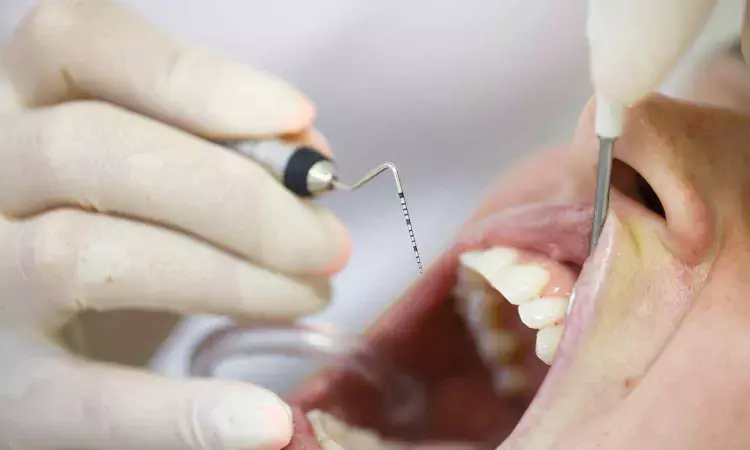- Home
- Medical news & Guidelines
- Anesthesiology
- Cardiology and CTVS
- Critical Care
- Dentistry
- Dermatology
- Diabetes and Endocrinology
- ENT
- Gastroenterology
- Medicine
- Nephrology
- Neurology
- Obstretics-Gynaecology
- Oncology
- Ophthalmology
- Orthopaedics
- Pediatrics-Neonatology
- Psychiatry
- Pulmonology
- Radiology
- Surgery
- Urology
- Laboratory Medicine
- Diet
- Nursing
- Paramedical
- Physiotherapy
- Health news
- Fact Check
- Bone Health Fact Check
- Brain Health Fact Check
- Cancer Related Fact Check
- Child Care Fact Check
- Dental and oral health fact check
- Diabetes and metabolic health fact check
- Diet and Nutrition Fact Check
- Eye and ENT Care Fact Check
- Fitness fact check
- Gut health fact check
- Heart health fact check
- Kidney health fact check
- Medical education fact check
- Men's health fact check
- Respiratory fact check
- Skin and hair care fact check
- Vaccine and Immunization fact check
- Women's health fact check
- AYUSH
- State News
- Andaman and Nicobar Islands
- Andhra Pradesh
- Arunachal Pradesh
- Assam
- Bihar
- Chandigarh
- Chattisgarh
- Dadra and Nagar Haveli
- Daman and Diu
- Delhi
- Goa
- Gujarat
- Haryana
- Himachal Pradesh
- Jammu & Kashmir
- Jharkhand
- Karnataka
- Kerala
- Ladakh
- Lakshadweep
- Madhya Pradesh
- Maharashtra
- Manipur
- Meghalaya
- Mizoram
- Nagaland
- Odisha
- Puducherry
- Punjab
- Rajasthan
- Sikkim
- Tamil Nadu
- Telangana
- Tripura
- Uttar Pradesh
- Uttrakhand
- West Bengal
- Medical Education
- Industry
New Study Links Triglyceride-Glucose Index to Increased Risk of Periodontitis

China: A recent study published in Frontiers in Endocrinology sheds light on a previously underexplored link between the triglyceride-glucose (TyG) index and periodontitis. Led by Jing Huang from the School of Nursing, Peking University, Beijing, China, the research utilized extensive datasets from two large-scale population surveys to explore this potential association.
"The observational analysis demonstrates a notable association between elevated TyG index levels and an increased risk of periodontitis," the authors wrote.
The study aimed to clarify whether elevated TyG index, a surrogate marker of insulin resistance, correlates with a higher risk of developing periodontitis. To achieve this, the researchers examined data from the National Health and Nutrition Examination Survey (NHANES, 2009–2014) and the Korea National Health and Nutrition Examination Survey (KNHANES, 2007–2018, excluding 2011).
The analysis included a total of 2,511 individuals with periodontitis from NHANES and 16,239 from KNHANES. The researchers employed multivariate logistic regression models, stratified and subgroup analyses, as well as restricted cubic spline (RCS) models to assess the nature and strength of the relationship between TyG index levels and periodontitis. Furthermore, the predictive performance of the TyG index was evaluated using receiver operating characteristic (ROC) curve analysis, and mediation analyses were conducted to explore underlying metabolic and inflammatory contributors.
The key findings include the following:
- Higher TyG index levels were significantly associated with an increased risk of periodontitis in both NHANES and KNHANES cohorts.
- In the NHANES dataset, individuals in the second quartile had a 20% higher risk of periodontitis compared to those in the lowest quartile (OR 1.20).
- In the same dataset, those in the highest quartile had a 23% increased risk (OR 1.23).
- In the KNHANES cohort, individuals in the highest quartile had a 9% greater risk of periodontitis (OR 1.09).
- These associations remained consistent even after adjusting for confounding variables, with a significant trend observed.
- Restricted cubic spline (RCS) analysis showed a nonlinear relationship between TyG index levels and periodontitis risk.
- Receiver operating characteristic (ROC) analysis showed the TyG index had moderate predictive capacity, with values of 8.24 in NHANES and 8.69 in KNHANES.
- Mediation analysis indicated that inflammatory markers (alkaline phosphatase and white blood cells) and metabolic factors (vitamin D and HDL cholesterol) partially mediated the association between the TyG index and periodontitis.
The authors concluded that this observational evidence supports a significant connection between metabolic dysfunction, as captured by the TyG index, and oral health outcomes. They call for further research to unpack the biological mechanisms and to assess whether the TyG index could serve as an early indicator for periodontal disease prevention strategies.
Reference:
Huang J, Zhang D, Li H, Zhang Y, Long T, Guo X, Cui H, Wei Z, Zhao J, Li M and Wang P (2025) Triglyceride-glucose index and periodontitis: evidence from two population-based surveys. Front. Endocrinol. 16:1558692. doi: 10.3389/fendo.2025.1558692
Dr Kamal Kant Kohli-MBBS, DTCD- a chest specialist with more than 30 years of practice and a flair for writing clinical articles, Dr Kamal Kant Kohli joined Medical Dialogues as a Chief Editor of Medical News. Besides writing articles, as an editor, he proofreads and verifies all the medical content published on Medical Dialogues including those coming from journals, studies,medical conferences,guidelines etc. Email: drkohli@medicaldialogues.in. Contact no. 011-43720751


